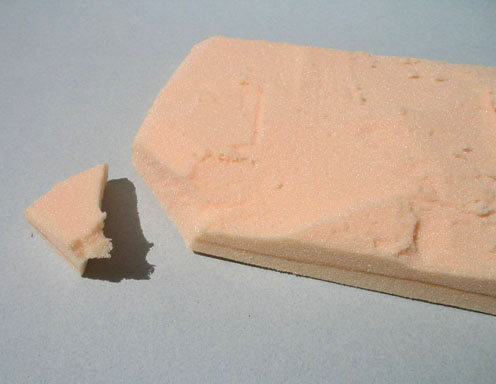1⁄1First Try at Sculpting Urethane Foam
7
Comments
The error was easily fixed later but you can benefit from my cluelessness. You can also see the marks I made with pastel chalks to guide my initial carving. I found this vital to keep from carving too far.
I carved too deeply in one instance, carelessly cutting away from myself toward an open corner and you can see the results. You need to be very cautious when cutting away from yourself into an open edge or corner, especially when the foam gets thin. It was easily glued back on as you will see but don’t let this happen to you. I tacked this small piece on with white glue and it worked fine for this little repair.
Comments
The same material can be found at Lowes and Home Depot for about $12-15 for a huge sheet. Also comes in various thicknesses, usually in pink or blue color. I was able to reduce some of the dust by using a hot wire for the initial cutting. Sanding is still a messy affair though. Good SBS. "Q"
OCT 26, 2007 - 01:10 AM
Sorry "Q", it's not the same pink or blue material you describe.
I would also caution against cutting any kind of foam with a hot wire as the melting releases gases that can cause harm.
Mike
OCT 26, 2007 - 07:40 AM
i find a far better material to work with for terrain is BALSA FOAM... sold in sheets of various sizes, the stuff is amazing. It "carves" like chalk, in that it is soft and easily scraped and sanded. Once the desired shape is obtained, you simply seal and paint it, or if you want to create molds of the finished peice (as I often do) dip it in MinWax Wood Hardener... this will make it hard as a rock in about one hour, and you can cast it in RTV rubber.
The only drawback to balsa foam is that is makes super fine dust, so you MUST wear a breathing mask... also, be sure to clean off your steel tools, as the stuff will rust steel pretty quickly if it comes in contact with water.
Here is a link with more information about the stuff... and of course, we stock it in our store, if you'd like to give it a try!
http://www.americanfoamtech.com/balsafoam/craftideas.asp
FEB 17, 2008 - 08:39 PM
Hi Keith,
While I can appreciate that this thread is a convenient way for you to advertise your shop, I wouldn't necessarily say that Balsa Foam is a better product for making diorama bases. I would call it a similar yet different product. What Rob used the foam for in this article, wouldn't have benefitted from using the denser Balsa Foam. I also think people need to look at the relative cost of the products and the size of the blocks available. Balsa Foam is more expensive.
My company offers a foam that I believe has merits and Rob has demonstrated what can be done on a first try. I'm wondering why the only comments are regarding what some ill informed people think are better alternatives. I would assume the Armorama staff would welcome articles on the experiences people have with 4' x 8' sheeets of building insulation or various sized blocks of Balsa Foam.
When I read them, I'll be sure to comment on the work presented and not the material used.
Respectfully,
Michael Bishop
FEB 27, 2008 - 07:56 PM
For Dio bases I would never use Balsa foam, for 1. too expensive. 2. it is better used for making buildings, furnishings etc. 3. regular styrofoam is cheaper and more durable, you can find local dealers and can use scraps for complete scenes.
I for one love balsa foam, and will more likely never buy another plastic building again. I can make them look like stone, wood siding, and brick. You can also use them for building you sidewalks and streets. or if you are really good making ornate sculptures and vases.
Just my opinion
JAN 27, 2009 - 04:59 PM
Copyright ©2021 by Rob Norton. Images and/or videos also by copyright holder unless otherwise noted. The views and opinions expressed herein are solely the views and opinions of the authors and/or contributors to this Web site and do not necessarily represent the views and/or opinions of Armorama, KitMaker Network, or Silver Star Enterrpises. All rights reserved. Originally published on: 2007-10-26 00:00:00. Unique Reads: 24139









